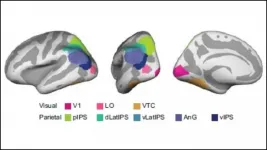(Press-News.org) Long before COVID-19 entered the picture, West Virginia had been battling two other major public health crises: opioids and HIV.
Dr. Sally Hodder, a leading infectious disease expert at West Virginia University, believes that despite the threat of COVID-19, the opioid and HIV epidemics should not be ignored. The two have become so intertwined in the Mountain State, that they must be treated together, she said.
"We cannot try to solve the opioid epidemic or our emerging HIV epidemic by combating them separately," said Hodder, who serves as director of the West Virginia Clinical and Translational Science Institute and associate vice president for clinical and translational research at WVU. "Since they are both so interconnected, we have to look at this as one larger issue, and treat it as such."
Hodder was recently published, along with WVU colleague and professor Judith Feinberg, in a Lancet series focused on the ongoing challenges to ending HIV. These challenges include racial, sexual and gender disparities; gaps in domestic HIV program funding; and a lack of access to treatment and prevention services. The Lancet is the world's oldest peer-reviewed general medical journal.
Hodder and Feinberg noted that while West Virginia has a variety of barriers (economic hardships, limited access to healthcare and treatment services) to combating these intertwined epidemics, one of the biggest obstacles that must be addressed is stigma.
"We won't be able to end the co-epidemics of HIV and opioids until we reduce the stigma associated with both substance abuse and HIV, especially in rural areas that may be suboptimally equipped to deal with these issues in the first place," Hodder said. "In places such as West Virginia, where the collapse of the coal mining industry and extreme poverty have exacerbated the opioid epidemic, decriminalizing substance abuse, providing clean, safe places for syringe service programs and other interventions, and offering comprehensive HIV prevention, care and treatment services are all essential to ending these intertwined epidemics."
West Virginia continues to lead the nation in drug overdose death rates at 51.5 per 100,000, according to the most recent Centers for Disease Control and Prevention data.
While West Virginia and Appalachia have historically seen very low HIV rates, the number of individuals who inject drugs has skyrocketed. This opioid epidemic-related transmission has led to multiple HIV clusters that have not been seen in the past.
"West Virginia has had HIV outbreaks across the southern coalfields, then in Cabell County, and most recently, in Kanawha County," said Dr. Feinberg, vice chair of research and professor, WVU School of Medicine. "In 2020, there were 37 new HIV diagnoses in Kanawha County compared to 38 in 2019 in all of New York City, leading the Centers for Disease Control and Prevention to say that this outbreak was currently their highest concern."
"What we saw in previous HIV outbreaks was that people lived in more urban areas," Hodder said. "This afforded them greater access to medical care and harm reduction services. These are things that are huge challenges in Appalachia. Geographical barriers may make finding and traveling to medical care and syringe services more difficult."
This is not the first time Hodder has fought HIV. After completing her medical training, she worked in Kenya and witnessed the emergence of AIDS in Africa. Hodder also spent 9 years running an HIV program in Newark, New Jersey, an area that at the time had an almost 3% HIV positive rate.
While there is still a lot of work to be done to combat these issues, Hodder remains hopeful.
"I have seen firsthand what communities can do together when people from multiple constituencies are part of the conversation," Hodder said. "Let's continue the great work that is ongoing in many West Virginia communities to provide necessary care, treatment and access to harm reduction that are all necessary to tackle HIV."
INFORMATION:
Citation: "The opioid crisis and HIV in the USA: deadly synergies"
WVCTSI Background
WVCTSI is funded by an IDeA Clinical and Translational grant from the National Institute of General Medical Sciences (U54GM104942) to support the mission of building clinical and translational research infrastructure and capacity to impact health disparities in West Virginia.
In order to remember similar events, the brain exaggerates the difference between them. This results in divergent brain activity patterns but better memory performance, according to new research published in JNeurosci.
Memory is subjective. Different people recall the same event in unique ways, and people exaggerate the difference between similar events in their own life. Yet this type of bias can be advantageous when it helps the brain distinguish between similar things and prevent confusion.
In a study by Zhao et al., participants memorized different sets of faces paired with colored objects. Some ...
The cover for issue 46 of Oncotarget features Figure 6, "Establishment of a SARS-CoV-2 pseudovirus that expresses SPIKE protein variants on the envelope of a lentiviral core, infection of human airway epithelial cells or lung cancer cells, and demonstration of MEKi attenuation of infectivity on primary human cells," published in "MEK inhibitors reduce cellular expression of ACE2, pERK, pRb while stimulating NK-mediated cytotoxicity and attenuating inflammatory cytokines relevant to SARS-CoV-2 infection" by Zhou, et al. which reported that Natural Killer cells and innate-immune TRAIL ...
Walk along the beach after a winter storm and you'll see a shore littered with wracks of giant kelp, some 30 to 40 feet long -- evidence of the storm's impact on coastal kelp forests.
Less apparent to the casual beachgoer is what happens to the submarine forests after the storm's fury dies down. This is precisely the topic of a new study led by Raine Detmer(link is external), a graduate student at UC Santa Barbara. She developed a mathematical model describing the effects of severe storms on kelp forest ecosystems, particularly the seafloor, or benthic, communities. The research, published in Ecology (link is external), reveals an ecosystem whose variability is key to its diversity.
Giant kelp ...
Graphs -- data structures that show the relationship among objects -- are highly versatile. It's easy to imagine a graph depicting a social media network's web of connections. But graphs are also used in programs as diverse as content recommendation (what to watch next on Netflix?) and navigation (what's the quickest route to the beach?). As Ajay Brahmakshatriya summarizes: "graphs are basically everywhere."
Brahmakshatriya has developed software to more efficiently run graph applications on a wider range of computer hardware. The software extends GraphIt, a state-of-the-art graph programming language, to ...
Understanding how the immune system responds to acute brain hemorrhage could open doors to identifying treatments for this devastating disease. However, up until now, there has been limited information on inflammation in the brain from human patients, especially during the first days after a hemorrhagic stroke.
This led a team of researchers to partner with a large clinical trial of minimally-invasive surgery to tackle defining the human neuroinflammatory response in living patients.
"Our goal was to find out, for the first time, how certain key cells of the immune system are activated when they enter the brain after a hemorrhage and how this may shift over the first week. This ...
For only the second time, astronomers have linked an elusive particle called a high-energy neutrino to an object outside our galaxy. Using ground- and space-based facilities, including NASA's Neil Gehrels Swift Observatory, they traced the neutrino to a black hole tearing apart a star, a rare cataclysmic occurrence called a tidal disruption event.
"Astrophysicists have long theorized that tidal disruptions could produce high-energy neutrinos, but this is the first time we've actually been able to connect them with observational evidence," said Robert Stein, a doctoral student at the German Electron-Synchrotron (DESY) research center in ...
In a time of extreme political polarization, hearing that a political candidate has taken a stance inconsistent with their party might raise some questions for their constituents.
Why don't they agree with the party's position? Do we know for sure this is where they stand?
New research led by University of Nebraska-Lincoln political psychologist Ingrid Haas has shown the human brain is processing politically incongruent statements differently -- attention is perking up -- and that the candidate's conviction toward the stated position is also playing a role.
In other words, there is a stronger neurological response happening when, for example, a Republican takes a position favorable to new taxes, ...
Abu Dhabi, UAE, February 22, 2021: Learning more about what motivates people to join violent ideological groups and engage in acts of cruelty against others is of great social and societal importance. New research from Assistant Professor of Psychology at NYUAD Jocelyn Bélanger explores the idea of ideological obsession as a form of addictive behavior that is central to understanding why people ultimately engage in ideological violence, and how best to help them break this addiction.
In the new study, END ...
Establishing a consistent sleep schedule for a toddler can be one of the most challenging aspects of child rearing, but it also may be one of the most important.
Research findings from a team including Lauren Covington, an assistant professor in the University of Delaware School of Nursing, suggest that children with inconsistent sleep schedules have higher body mass index (BMI) percentiles. Their findings, published in the Annals of Behavioral Medicine, suggest sleep could help explain the association between household poverty and BMI.
"We've known for a while that physical activity and diet quality are very strong predictors of weight and BMI," said Covington, the lead author of the article. "I think it's really highlighting that ...
February 22, 2021 - Widely used medications for benign prostatic hyperplasia (BPH) - also known as enlarged prostate - may be associated with a small, but significant increase in the probability of developing heart failure, suggests a study in The Journal of Urology®, Official Journal of the American Urological Association (AUA). The journal is pub lished in the Lippincott portfolio by Wolters Kluwer.
The risk is highest in men taking a type of BPH medication called alpha-blockers (ABs), rather than a different type called 5-alpha reductase inhibitors (5-ARIs), according to the new research by D. Robert Siemens, MD, and ...





